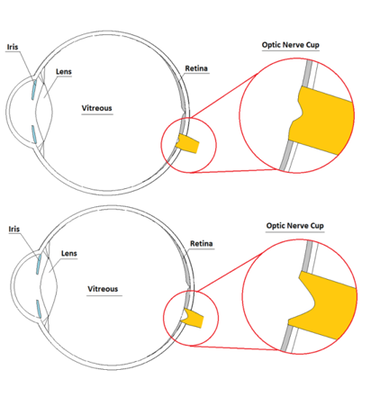Normal - Mild - Moderate - Severe
Glaucoma

Glaucoma is a disease of the optic nerve. The optic nerve is the nerve that connects the eye to the brain. In glaucoma, the pressure inside the eye becomes too great and slowly crushes the optic nerve which leads to a loss of peripheral (side) vision.
Untreated glaucoma can cause complete and irreversible blindness. This makes glaucoma a serious eye disease and one of the leading causes of blindness in the U.S. In a small percentage of cases we can see a blockage of the fluid flowing out of the eye. These cases can often be treated with a laser procedure.
Unfortunately glaucoma usually does not have any symptoms until the disease is in the end stage. This makes it important to have your eyes examined regularly and tested as directed by your doctor. End stage glaucoma has symptoms of significantly decreased peripheral (side) vision.
Even in the early stages, glaucoma can be detected during a thorough eye exam. Examination includes measuring the pressure of the fluid inside the eye, visual examination of the optic nerve with a special microscope and lens, and assessment of side vision. Additional testing may be ordered when suspicious findings are noted during an eye examination.
These tests often include:
- OCT - this instrument scans the optic nerve for loss or thinning of nerve fiber. This is one of the earliest signs of glaucoma
- Pachymetry - measurement of the thickness of the cornea (the front surface of the eye). Cornea thickness affects measurement of pressure inside the eye, so it is important to know corneal thickness to accurately monitor intraocular pressure
- Visual Field Testing - measurement and mapping of the peripheral (side) vision. Glaucoma has very characteristic patterns of side vision loss. Visual field testing can pick up these losses very early, even when they are not apparent to you.
- Gonioscopy - measurement of the anterior chamber angle. This is the area inside the eye where the fluid drains back into the body's circulatory system.
- VEP/ ERG - measures the time it takes electrical signals to travel from the back of the eye to the brain.
Glaucoma is treated by trying to decrease the pressure inside the eye. Prescription eye drops are usually very effective and often only have to be administered once or twice a day. However some cases of glaucoma require surgical intervention.


